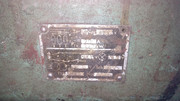That's very interesting. As said I'd never even heard of anything like this before, I suppose it could have been set up for turning standard tapers much quicker than a taper attachment. Was a pretty sizeable machine though, wouldn't have fitted in my shed : P From memory it could also cut just about every thread in existence and I suspect you needed a special license to operate.


 LinkBack URL
LinkBack URL About LinkBacks
About LinkBacks


 Reply With Quote
Reply With Quote




















Bookmarks